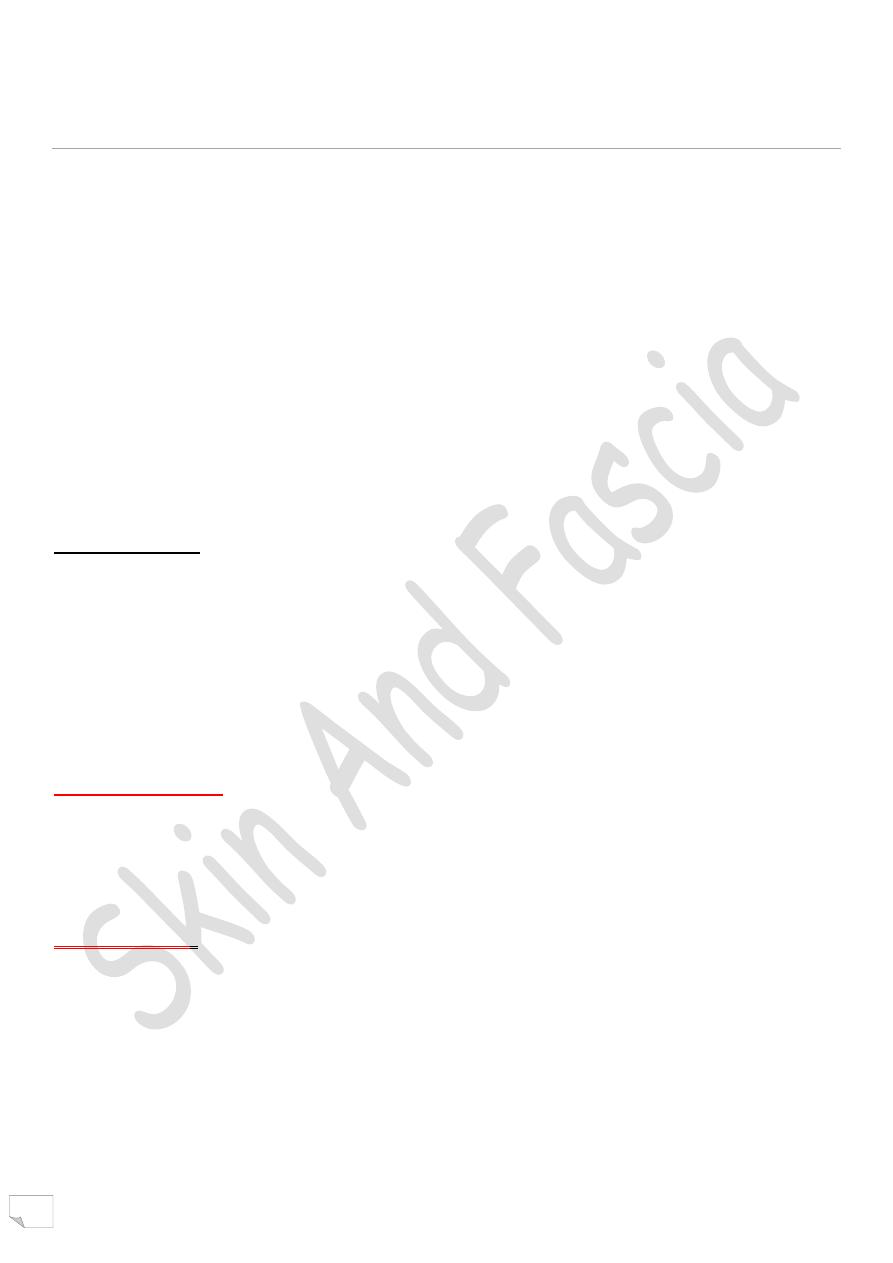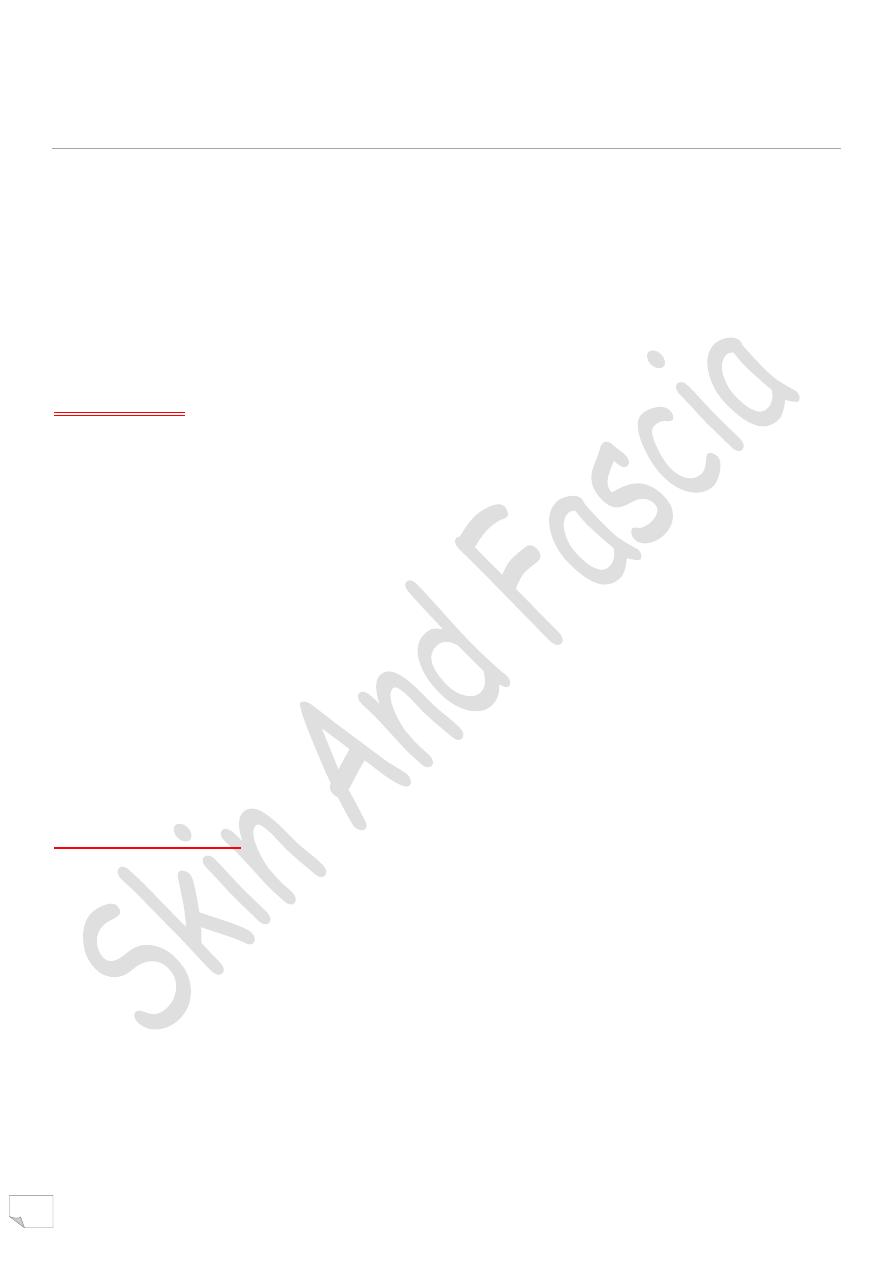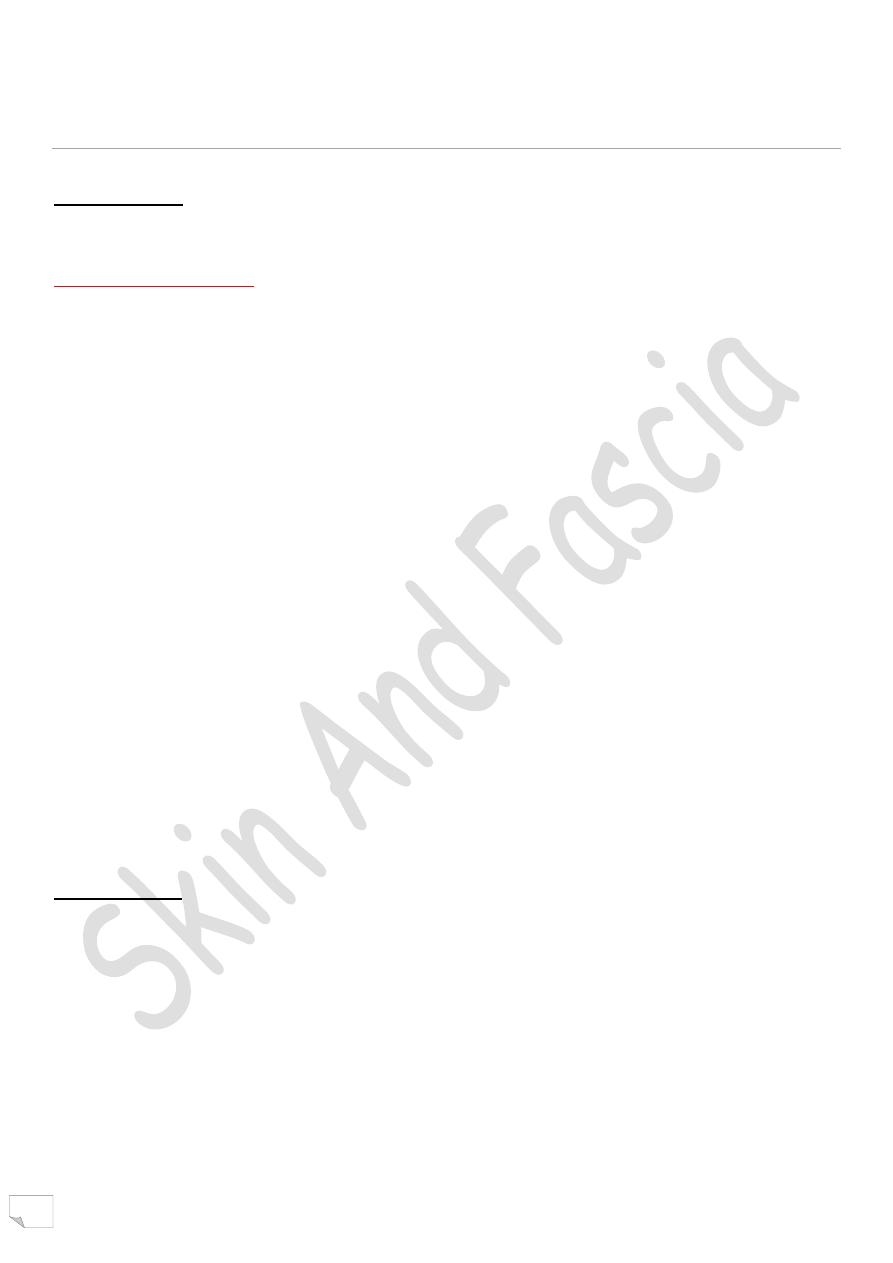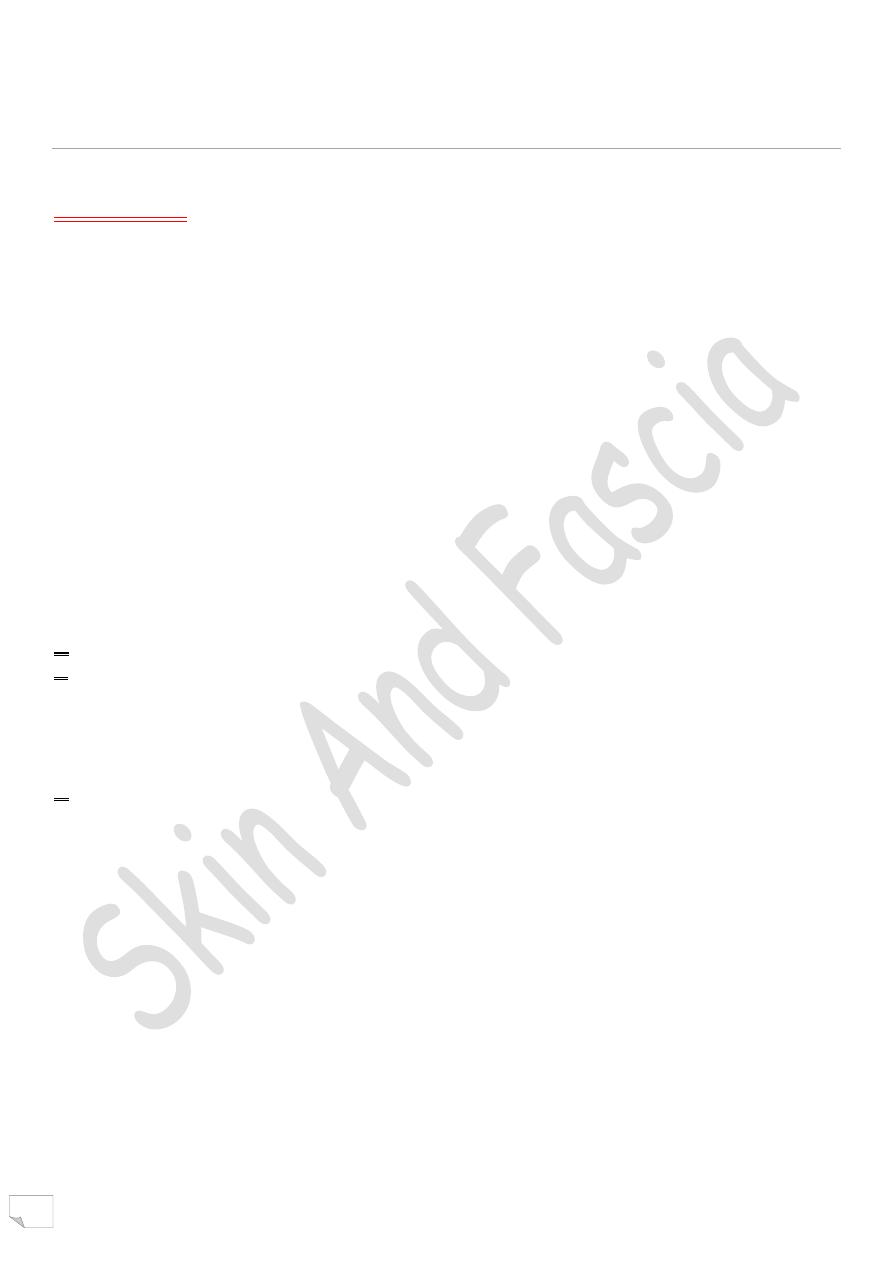
Basic Anatomical structures
Dr : Hassna Bader
8/12/2015
1
Skin &Fascia
Objective:
•
Describe layers of skin.
•
Enlist the functions of skin.
•
Recognize the importance of skin creases and relate this to applied anatomy (surgical
incisions)
•
Define appendages of skin.
•
Define fascia.
•
Differentiate between superficial and deep fascia.
•
--------------------------------------------------------------------------------------------------------
Skin
Skin with its accessory organs sweat ,sebaceous , glands and hair follicles forms the
largest organ of the body 1.5-2 m
2
and about 16% of body weight .
Function of skin
•
1-Protection
•
Protects the under lying structures from abrasion, invasion, water loss and UV
•
2-Vitamin D synthesis
•
Epidermal keratinocytes when exposed to UV light synthesis vit. D.
•
3-Sensation
•
Skin contains receptors for heat, cold, touch, pressure, vibration and pain.
•
4- Thermoregulation
•
Skin contains thermo receptors and sweat glands
•
5- Psychological and social functions
kin
S
Structures Of
The skin is made up of three main layers:
•
1.Epidermis
•
2.Dermis
•
3.Subcutaneous Hypodermis ( fascia)
Epidermis
1.
The epidermis is generally thin except in the palm and the sole of the feet it is thick to
protect these parts and withstand friction, wear and tear that occurs in these regions
•
Epidermis consists of 3 layers:
1-Stratum corneum (horny layer)
This layer contains continually shedding, dead keratinocytes .
2.Stratum granuloza
3.Stratum spinoza
This layer contains living keratinocytes (squamous cells), which help to provide the
skin with what it needs to protect the rest of the body.

Basic Anatomical structures
Dr : Hassna Bader
8/12/2015
2
4-Basal layer
The basal layer is the inner layer of the epidermis, containing basal cells. Basal cells
continually divide, forming new keratinocytes and replacing the old ones that are
shed from the skin's surface
The epidermis also contains melanocytes, which are cells that produce melanin (skin
pigment).
Dermis
2.
Connective tissue containing (blood vessels, lymph vessels, sensory nerve endings,
smooth muscles, hair follicles, sweat and sebaceous glands)
In its deep part the collagen bundles are arranged in parallel rows.
The dermis layer is made up of two sub layers:
1.The papillary layer:
Contains a thin arrangement of collagen fibers.
*It supplies nutrients to the epidermis
*regulates temperature.
2.The reticular layer :
Is thicker and made of thick collagen fibers that are arranged in
parallel to the surface of the skin.
*strengthens the skin, providing structure and elasticity.
*supports other components of the skin, such as hair follicles, sweat
glands, and sebaceous glands
•
also
The collagen fibers, arranged in parallel rows,
:
*Lines of cleavage
called Langer's lines
•
The direction of arrangement of the rows of collagen fibers in the
dermis are:
•
*Longitudinally in the limbs.
•
*Circumferentially in the neck and the trunk.
•
These lines are important to determine the direction for an incision during a
surgery to avoid obvious scars.
•
Clinical Note:
•
*A surgical incision along or between these lines causes the minimum disruption
of collagen so that the wound heals with a small scar.
•
Conversely, an incision made across the rows of collagen makes a disruption
resulting in the massive production of fresh collagen and the formation of a
broad scar.

Basic Anatomical structures
Dr : Hassna Bader
8/12/2015
3
to
close
is thin and is firmly
the skin
where
joint
Are folds over the
:
Skin creases
underlying structures .
:
Skin appendages
1. Nails :
Is a flat horny plate on the dorsal surface of tips of the fingers and toes.
It has 3 parts:
* Root: proximal edge (part embedded in skin)
* body: exposed part & has a free distal edge
*Nail fold: folds of skin surround and overlap the nail.
2. Hairs:
*Hair follicles: invaginations of the epidermis into the dermis, the hair grows out of these follicles
(hair shaft).
*Hair bulb: the expanded extremity of the follicle, concaved at the end (located deep in the dermis).
*Hair papilla: a vascular connective tissue that occupies the concavity
of the bulb.
*Arrector Pilli muscle
•
A band of smooth muscle connects the undersurface of the follicle to the
superficial part of the dermis. It is innervated by sympathetic fiber.
•
Its contraction causes the hair to move into a more vertical position. It
compresses the sebaceous gland and causes it to secret sebum.
•
3. Sebaceous gland:
Lies within the dermis sloping under surface of the hair follicles. It secrets sebum to
oil (lubricate) hair and skin.
Sebum is an oily material that keeps the flexibility of the hair and oils the epidermis
around the mouth of the follicle.
of the
*sebaceous cyst : is formed due to obstruction of the duct
Clinical Note
sebaceous gland due to infection
4. Sweat gland:
•
Is a long tubular glands with deep coiled part found all over the body except red
margins of lips, nail beds, glans penis and clitoris..
•
It is the most deeply penetrating structures of all epidermal appendages extends
through the full thickness of dermis .

Basic Anatomical structures
Dr : Hassna Bader
8/12/2015
4
the
between skin and
ollection of connective tissues
Is a c
:
Fascia
3.
underlying muscles and bones. It is divided into 2 types:
1.Superficial fascia:
•
Loose, mixture of adipose and loose areolar tissues unites the skin to the
underlying structures. It is dense in some places as scalp, palm of hand and sole
of foot and contains collagen bundles, and is thin in the eyelids, auricle, scrotum,
penis and clitoris (devoid of adipose tissue).
Functions:
•
*Facilitates movement of skin over underlying structures.
•
*Passage for cutaneous vessels, nerves…
•
*Protects the body against heat loss.
•
2.Deep fascia:
It is more dense than superficial fascia .The collagen bundle are more compact and
more regularly arranged. It is usually presented in the form of membranes. it
presented in a form of :
lie between muscles dividing the limb into compartments
. Inter muscular septum
A
•
Covers the surfaces of muscles
. Investing fascia:
B
•
*In the neck: it forms well-defined layers, bounds fascial spaces so limits spread
of infection or determine the path of infection.
•
*In the abdomen: it is thin covering the muscles.
•
*In the limbs: forms a definite sheath around the muscles.
scia around joints, hold the tendons
Localized thickening of deep fa
Retinaculum:
.
C
in place, prevent bowstringing of tendons.
